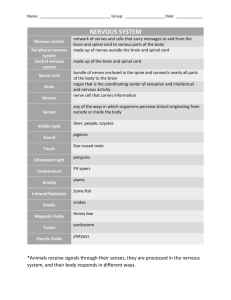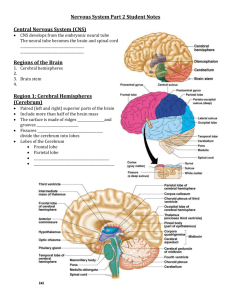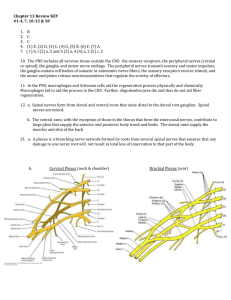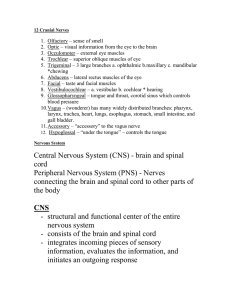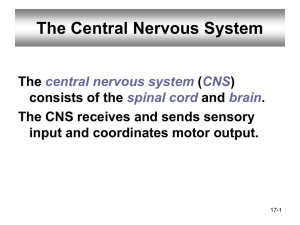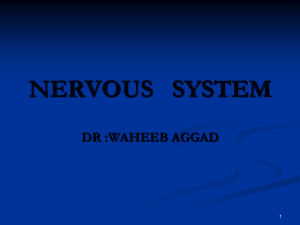Nervous System
advertisement
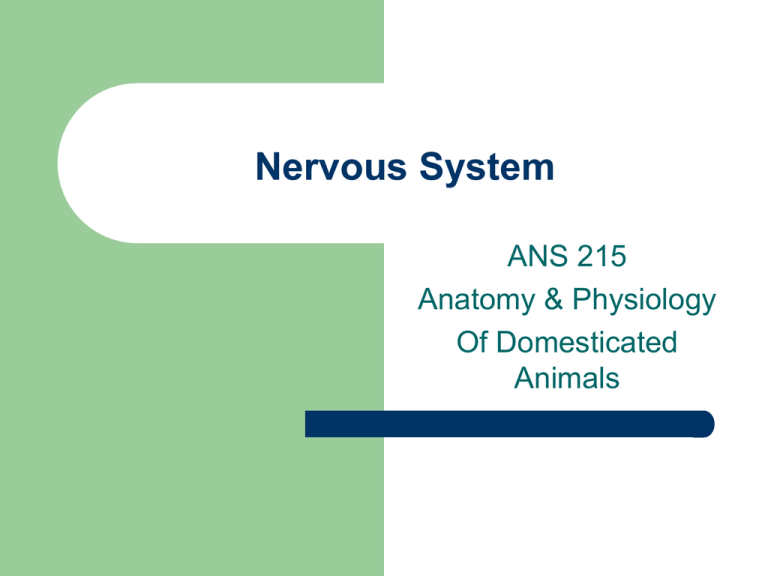
Nervous System ANS 215 Anatomy & Physiology Of Domesticated Animals Neuron Functional unit of the nervous system Consists of: cell body, axon, dendrites Neuron Cell membrane = axolemma Myelin sheath = neurolemma; Increases the speed of conduction Mammalian neurons can be bipolar (on axon and one dendrite) or multipolar (many branching dendrites and one axon) The axon and its myelin sheath are called a nerve fiber Synapse Oligodendrocyte Node of Ranvier Nervous System Organization Central Nervous System (CNS) – – Brain Spinal cord Peripheral Nervous System (PNS) – – – – Cranial nerves Spinal nerves Autonomic nerves ganglia Subdivisions of the Brain Subdivisions of the Brain Location of Brain Subdivisions Sources of Input to Cerebellum The Brain Brain Stem Midbrain – – – Visual reflex center Auditory reflex center Nuclei and fiber tracts Pons and Medulla Oblongata – – Up and down pathways Reflex centers Brain Stem Interbrain – – – Hypothalamus – integration Thalamus – relay center Epithalamus – olfactory and pineal gland Cerebellum Not concerned with consciousness or sensation Controls motor function Makes adjustments to prevent distortion of inertia and momentum Basal Ganglia Control of complex semi-voluntary movements (walking, running) Lie deep within the cerebral hemispheres Composed of separate, large pools of neurons Cerebrum Cortex – covering of gray matter Medulla – white matter – – Association fibers, commissural fibers (connect two hemispheres) Projection fibers (connect cortex to other parts of brain and spinal cord) Cerebrum 2 hemispheres that contain: - Sensory areas - Reactions that result in consciousness - High degree of educability - Decussation - Motor area size and number of complex skeletal muscles movements Evolution and Growth of the Cerebrum Evolution of Cerebral Hemispheres Evolution of the cerebral hemispheres as seen in cross sections. Only the left hemisphere is shown in the lower figures. Light gray indicates the paleostriatum. Reptiles and birds have added new nuclear masses (neostriatum and hyperstriatum). Mammals have developed a cortex. Note the old striatal complex (now called basal ganglia) still present in the mammal. Brain and Spinal Nerves Spinal Cord Most caudal portion of the Central Nervous System Continuation of medulla Segmented, 31 pairs of spinal nerves Sensory – afferent fibers Motor – efferent fibers Ascending pathways – sensory information Descending pathways – motor information Spinal Nerve Cranial Nerves


